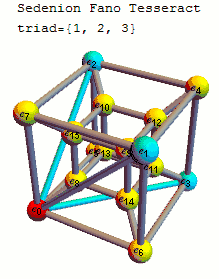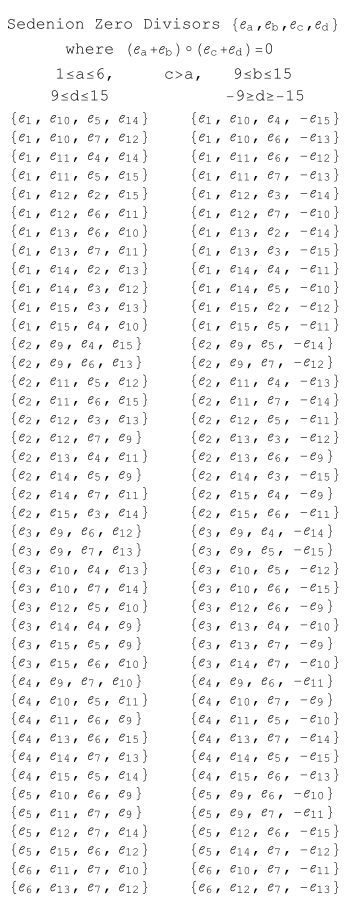Sedenion
In abstract algebra, the sedenions form a 16-dimensional noncommutative and nonassociative algebra over the reals; they are obtained by applying the Cayley–Dickson construction to the octonions, and as such the octonions are a subalgebra of the sedenions. Unlike the octonions, the sedenions are not an alternative algebra. Applying the Cayley–Dickson construction to the sedenions yields a 32-dimensional algebra, sometimes called the 32-ions or Trigintaduonions.[1] It is possible to apply the Cayley–Dickson construction to the sedenions arbitrarily many times.
| Sedenions | |
|---|---|
| Symbol | |
| Type | nonassociative algebra |
| Units | e0...e15 |
| Multiplicative identity | e0 |
| Main properties | power associativity distributivity |
| Common Systems | |
| |
The term sedenion is also used for other 16-dimensional algebraic structures, such as a tensor product of two copies of the biquaternions, or the algebra of 4 by 4 matrices over the reals, or that studied by Smith (1995).
Arithmetic

Like octonions, multiplication of sedenions is neither commutative nor associative. But in contrast to the octonions, the sedenions do not even have the property of being alternative. They do, however, have the property of power associativity, which can be stated as that, for any element x of , the power is well defined. They are also flexible.
Every sedenion is a linear combination of the unit sedenions , , , , ...,, which form a basis of the vector space of sedenions. Every sedenion can be represented in the form
- .
Addition and subtraction are defined by the addition and subtraction of corresponding coefficients and multiplication is distributive over addition.
Like other algebras based on the Cayley–Dickson construction, the sedenions contain the algebra they were constructed from. So, they contain the octonions (generated by to in the table below), and therefore also the quaternions (generated by to ), complex numbers (generated by and ) and reals (generated by ).
The sedenions have a multiplicative identity element and multiplicative inverses but they are not a division algebra because they have zero divisors. This means that two non-zero sedenions can be multiplied to obtain zero: an example is ( + )( − ). All hypercomplex number systems after sedenions that are based on the Cayley–Dickson construction contain zero divisors.
A sedenion multiplication table is shown below:
multiplication table | |||||||||||||||||||||||||||||||||||||||||||||||||||||||||||||||||||||||||||||||||||||||||||||||||||||||||||||||||||||||||||||||||||||||||||||||||||||||||||||||||||||||||||||||||||||||||||||||||||||||||||||||||||||||||||||||||||||||||||||||||||||||||||||||||||||||||||||||||||||||||||||||||||||||||||||||||||||
|---|---|---|---|---|---|---|---|---|---|---|---|---|---|---|---|---|---|---|---|---|---|---|---|---|---|---|---|---|---|---|---|---|---|---|---|---|---|---|---|---|---|---|---|---|---|---|---|---|---|---|---|---|---|---|---|---|---|---|---|---|---|---|---|---|---|---|---|---|---|---|---|---|---|---|---|---|---|---|---|---|---|---|---|---|---|---|---|---|---|---|---|---|---|---|---|---|---|---|---|---|---|---|---|---|---|---|---|---|---|---|---|---|---|---|---|---|---|---|---|---|---|---|---|---|---|---|---|---|---|---|---|---|---|---|---|---|---|---|---|---|---|---|---|---|---|---|---|---|---|---|---|---|---|---|---|---|---|---|---|---|---|---|---|---|---|---|---|---|---|---|---|---|---|---|---|---|---|---|---|---|---|---|---|---|---|---|---|---|---|---|---|---|---|---|---|---|---|---|---|---|---|---|---|---|---|---|---|---|---|---|---|---|---|---|---|---|---|---|---|---|---|---|---|---|---|---|---|---|---|---|---|---|---|---|---|---|---|---|---|---|---|---|---|---|---|---|---|---|---|---|---|---|---|---|---|---|---|---|---|---|---|---|---|---|---|---|---|---|---|---|---|---|---|---|---|---|---|---|---|---|---|---|---|---|---|---|---|---|---|---|---|---|---|---|---|---|---|---|---|---|---|---|---|---|---|---|---|---|---|
| |||||||||||||||||||||||||||||||||||||||||||||||||||||||||||||||||||||||||||||||||||||||||||||||||||||||||||||||||||||||||||||||||||||||||||||||||||||||||||||||||||||||||||||||||||||||||||||||||||||||||||||||||||||||||||||||||||||||||||||||||||||||||||||||||||||||||||||||||||||||||||||||||||||||||||||||||||||
Sedenion properties
From the above table, we can see that:
Anti-associative
The sedenions are not fully anti-associative. Choose any four generators, and . The following 5-cycle shows that at least one of these relations must associate.
In particular, in the table above, using and the last expression associates.
Quaternionic subalgebras
The 35 triads that make up this specific sedenion multiplication table with the 7 triads of the octonions used in creating the sedenion through the Cayley–Dickson construction shown in bold:
The binary representations of the indices of these triples xor to 0.
{{1, 2, 3}, {1, 4, 5}, {1, 7, 6}, {1, 8, 9}, {1, 11, 10}, {1, 13, 12}, {1, 14, 15},
{2, 4, 6}, {2, 5, 7}, {2, 8, 10}, {2, 9, 11}, {2, 14, 12}, {2, 15, 13}, {3, 4, 7},
{3, 6, 5}, {3, 8, 11}, {3, 10, 9}, {3, 13, 14}, {3, 15, 12}, {4, 8, 12}, {4, 9, 13},
{4, 10, 14}, {4, 11, 15}, {5, 8, 13}, {5, 10, 15}, {5, 12, 9}, {5, 14, 11}, {6, 8, 14},
{6, 11, 13}, {6, 12, 10}, {6, 15, 9}, {7, 8, 15}, {7, 9, 14}, {7, 12, 11}, {7, 13, 10}}
The list of 84 sets of zero divisors {, , , }, where ( + )( + )=0:

Applications
Moreno (1998) showed that the space of pairs of norm-one sedenions that multiply to zero is homeomorphic to the compact form of the exceptional Lie group G2. (Note that in his paper, a "zero divisor" means a pair of elements that multiply to zero.)
Notes
- Raoul E. Cawagas, et al. (2009). "THE BASIC SUBALGEBRA STRUCTURE OF THE CAYLEY-DICKSON ALGEBRA OF DIMENSION 32 (TRIGINTADUONIONS)".
- (Baez 2002, p. 6)
References
- Imaeda, K.; Imaeda, M. (2000), "Sedenions: algebra and analysis", Applied Mathematics and Computation, 115 (2): 77–88, doi:10.1016/S0096-3003(99)00140-X, MR 1786945
- Baez, John C. (2002). "The Octonions". Bulletin of the American Mathematical Society. New Series. 39 (2): 145–205. arXiv:math/0105155. doi:10.1090/S0273-0979-01-00934-X. MR 1886087.CS1 maint: ref=harv (link)
- Biss, Daniel K.; Christensen, J. Daniel; Dugger, Daniel; Isaksen, Daniel C. (2007). "Large annihilators in Cayley-Dickson algebras II". Boletin de la Sociedad Matematica Mexicana. 3: 269–292. arXiv:math/0702075.
- Kinyon, M.K.; Phillips, J.D.; Vojtěchovský, P. (2007). "C-loops: Extensions and constructions". Journal of Algebra and Its Applications. 6 (1): 1–20. arXiv:math/0412390. CiteSeerX 10.1.1.240.6208. doi:10.1142/S0219498807001990.
- Kivunge, Benard M.; Smith, Jonathan D. H (2004). "Subloops of sedenions" (PDF). Comment. Math. Univ. Carolinae. 45 (2): 295–302.
- Moreno, Guillermo (1998), "The zero divisors of the Cayley–Dickson algebras over the real numbers", Bol. Soc. Mat. Mexicana, Series 3, 4 (1): 13–28, arXiv:q-alg/9710013, Bibcode:1997q.alg....10013G, MR 1625585
- Smith, Jonathan D. H. (1995), "A left loop on the 15-sphere", Journal of Algebra, 176 (1): 128–138, doi:10.1006/jabr.1995.1237, MR 1345298